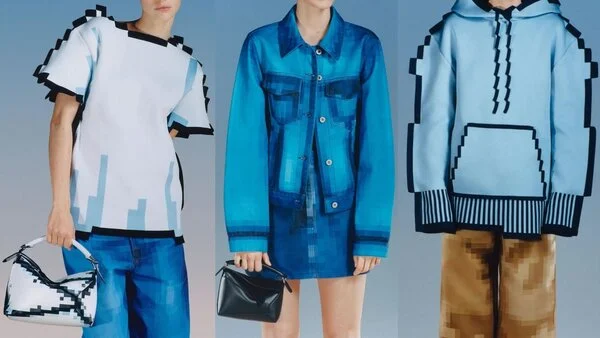Hyperrealism in fashion: A new realm for luxury

Fashion is now hyperrealistic, blurring the lines between real and virtual. This new trend is appealing to Gen Z customers and luxury brands are taking notice.
Loewe’s Spring/Summer 2023 collection was a key influence in the trend. The collection included a capsule of pixel clothes that became a social media hit. Creative director Jonathan Anderson asked questions in his show notes about how we are falling into the screen and becoming our phones. Loewe’s embrace of the hyperreal helped to make them the hottest brand in the world in Q2 2023.
Clothes made for spectacle, not function
Clothes made to be worn online without any physical existence are driving the trend. The Mschf Big Red Boots are an example of a hyperrealistic fashion trend. They were not meant to be worn, but they became a bestseller because they are visually striking. Celebrities like Victoria Beckham and Diplo have also worn them. The Loewe pixel collection is another example of a hyperrealistic fashion trend. Clothes made to look like pixelated video game characters are included in the collection. They have also been popular with consumers and have become somewhat of a collectible. The changing way people consume fashion is driving the rise of hyperrealism in fashion.

People are spending more time online and are increasingly interested in clothes that look good in photos. Hyperrealistic clothes are designed to look good in photos and are often shared on social media. It is still too early to say whether hyperrealism will change the direction of fashion. However, it is clear that the trend is gaining popularity and is likely to continue to grow in the future.
Authenticity in the digital age
Trends commentator Panzoni suggests that younger generations expect brands to understand their online culture. The AI revolution is changing our idea of reality, and brands are experimenting with tech-powered craft to create what is physically impossible, blurring the lines between online and offline.

Designer Andrea Albrizio believes that digital will never replace physical fashion, but he is excited about the concept of a world where clothes have a digital extension. He says that the goal is to make this element useful, otherwise consumers will lose interest quickly. His next collection will reconnect with fashion through gamification, working with video game themes and ideas. He believes that brands that manage to crack this formula will be the ones that succeed in the coming years.


- Art
- Causes
- Best Offers
- Crafts
- Dance
- Drinks
- Film
- Fitness
- Food
- Jogos
- Festival
- Gardening
- Health
- Início
- Literature
- Music
- Networking
- Outro
- Party
- Religion
- Shopping
- Sports
- Theater
- Wellness



